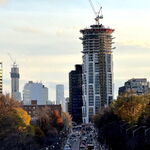BurlOak
Senior Member
Just resurrect the Crosstown GO route from Erindale to mid-Pickering, and throw in an Etobicoke RT which can connect at Long Branch, Sherway, Line 2, Pearson, and more.
Something like this. I would guess Bus with shoulder lanes on 427. Very little is needed - just an on ramp just north of Cloverdale for 427 NB.
If there is a Woodbine GO station added, I would go across Dixon and run up 27 instead of 427 from Pearson.
It does seem that the 3km detour to get from 427 to Kipling hurts the line. Probably adds 10 minutes or more to the trip.





